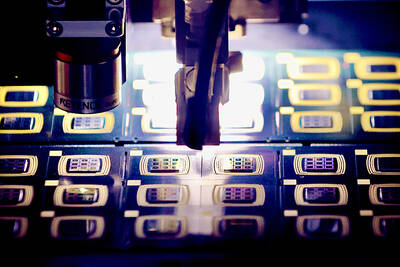The world’s largest rodent is having a big moment.
The capybara — a semi-aquatic South American relative of the guinea pig — is the latest in a long line of “it” animals to get star treatment during the holiday shopping season.
Shoppers can find capybara slippers, purses, robes and bath bombs. There are cuddly plush capybaras and stretchy or squishy ones. Tiny capybaras wander across bedding, T-shirts, phone cases, mugs, key chains and almost any other type of traditional gift item.

Photo: Palm Beach Zoo via AFP
Last year, it was the axolotl that took pride of place on many products, and the endangered amphibian remains popular. Owls, hedgehogs, foxes and sloths also had recent turns in the spotlight.
Trendy animals and animal-like creatures are not a new retail phenomenon; think the talking Teddy Ruxpin toys of the 1980s or Furby and Beanie Babies a decade later. However, industry experts say social media is amplifying which animals are hot — or not.
“It’s really the launch on TikTok, Instagram and other social media platforms that allow these characters or animals to blow up like crazy,” said Richard Derr, who has owned a Learning Express Toys franchise in Lake Zurich, Illinois, for nearly 30 years and is also a regional manager for the specialty toy store chain.
Social media is also speeding up the cycle.
Must-have animals might only last a season before something new captures customers’ imaginations.
“It’s really important to keep feeding that beast,” said Juli Lennett, a vice president and toy industry advisor at market research firm Circana. “If you are an influencer, you’re not going to talk about last year’s stuff.”
Skyrocketing plush toy sales — fueled by a need for comfort during the pandemic — are also increasing the demand for new and interesting varieties, Lennett said.
In the first nine months of this year, sales of plush animals were up 115 percent from the same period in 2019, she said. Overall toy sales rose 38 percent in that time.
Consumers are seeking out increasingly exotic species that they see in online videos, games and movies. Highland cows, red pandas and axolotls, a type of salamander native to Mexico, have all popped up in popular culture.
Searches for axolotls shot up in June 2021 after Minecraft added them to its game, Google Trends showed.
“Nobody knew what an axolotl was in 2020,” Derr said. “Now, everybody knows axolotls.”
Vermont Teddy Bear Company product designer Cassandra Clayton said rising sales to adults are also fueling the demand for unique — and collectible — plush toys.
“Stuffed animals are really becoming an ageless item,” she said. “Especially with the boom of self-care in adults and turning towards comfort objects to help de-stress and relax in your life.”
Clayton said she expects demand for unusual stuffed animals to continue to grow. Among the oddest she has seen: a stuffed version of a water bear, a type of microorganism also known as a moss piglet or a tardigrade.
“It doesn’t necessarily inspire you to cuddle with them, but you’re really seeing the industry start turning towards those characters,” she said. “I think that’s the next trend.”
Figuring out the next “it” animal — or microorganism — is a challenge for toymakers.
“You never know exactly when they’re going to hit and how big they’re going to be,” said Sharon Price John, the president and CEO of Build-A-Bear Workshop, a chain of nearly 500 stores that offers an expanding menagerie of animals and characters for customers to customize, including capybaras and axolotls.
The St Louis-based company watches social media and gets ideas from talking to store employees and patrons, John said.
It usually takes Build-A-Bear up to a year to introduce a new stuffed toy, but the company can move faster if it spots a trend, she said, adding that it sometimes tests a small batch online to make sure a trend is sticking.
Annual trade shows in Asia, Germany and elsewhere are another place to spot new trends.
Punirunes — digital, interactive pets that also come in plush varieties — are big in Japan right now and would likely take off in the US, toy store owner Derr said.
“Here, I can’t give them away. They’re too new. But give it a year or two,” he said.
Companies can kick off their own trends too. Build-A-Bear’s Spring Green Frog, introduced in 2020, was an immediate hit thanks to videos posted by customers.
It remains popular, with nearly 2 million sold, John said.
John said she suspects people are drawn to friendly, slow-moving capybaras, because watching videos of them are so relaxing. However, shoppers who want one need to act fast. A Build-A-Bear holiday capybara with red and green sprinkles on its fur — dubbed a “cookiebara” — has already sold out, she said.

AI SERVER DEMAND: ‘Overall industry demand continues to outpace supply and we are expanding capacity to meet it,’ the company’s chief executive officer said Hon Hai Precision Industry Co (鴻海精密) yesterday reported that net profit last quarter rose 27 percent from the same quarter last year on the back of demand for cloud services and high-performance computing products. Net profit surged to NT$44.36 billion (US$1.48 billion) from NT$35.04 billion a year earlier. On a quarterly basis, net profit grew 5 percent from NT$42.1 billion. Earnings per share expanded to NT$3.19 from NT$2.53 a year earlier and NT$3.03 in the first quarter. However, a sharp appreciation of the New Taiwan dollar since early May has weighed on the company’s performance, Hon Hai chief financial officer David Huang (黃德才)

The Taiwan Automation Intelligence and Robot Show, which is to be held from Wednesday to Saturday at the Taipei Nangang Exhibition Center, would showcase the latest in artificial intelligence (AI)-driven robotics and automation technologies, the organizer said yesterday. The event would highlight applications in smart manufacturing, as well as information and communications technology, the Taiwan Automation Intelligence and Robotics Association said. More than 1,000 companies are to display innovations in semiconductors, electromechanics, industrial automation and intelligent manufacturing, it said in a news release. Visitors can explore automated guided vehicles, 3D machine vision systems and AI-powered applications at the show, along

FORECAST: The greater computing power needed for emerging AI applications has driven higher demand for advanced semiconductors worldwide, TSMC said The government-supported Industrial Technology Research Institute (ITRI) has raised its forecast for this year’s growth in the output value of Taiwan’s semiconductor industry to above 22 percent on strong global demand for artificial intelligence (AI) applications. In its latest IEK Current Quarterly Model report, the institute said the local semiconductor industry would have output of NT$6.5 trillion (US$216.6 billion) this year, up 22.2 percent from a year earlier, an upward revision from a 19.1 percent increase estimate made in May. The strong showing of the local semiconductor industry largely reflected the stronger-than-expected performance of the integrated circuit (IC) manufacturing segment,

COLLABORATION: Softbank would supply manufacturing gear to the factory, and a joint venture would make AI data center equipment, Young Liu said Hon Hai Precision Industry Co (鴻海精密) would operate a US factory owned by Softbank Group Corp, setting up what is in the running to be the first manufacturing site in the Japanese company’s US$500 billion Stargate venture with OpenAI and Oracle Corp. Softbank is acquiring Hon Hai’s electric-vehicle plant in Ohio, but the Taiwanese company would continue to run the complex after turning it into an artificial intelligence (AI) server production plant, Hon Hai chairman Young Liu (劉揚偉) said yesterday. Softbank would supply manufacturing gear to the factory, and a joint venture between the two companies would make AI data